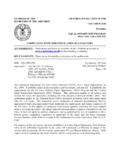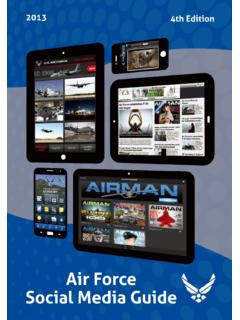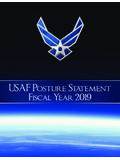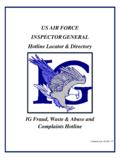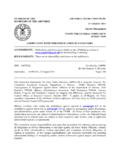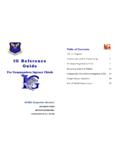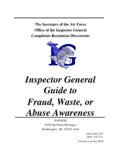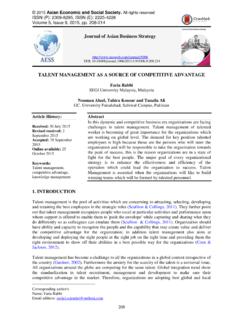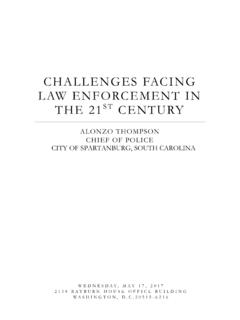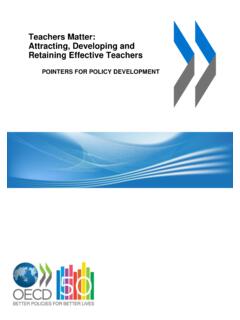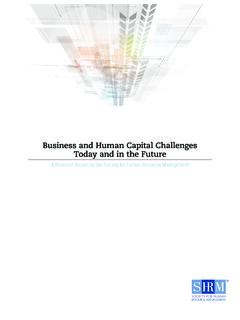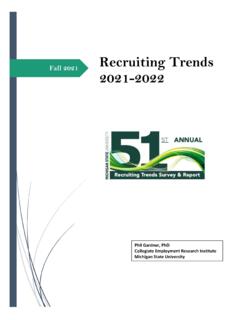Transcription of Human Capital Annex to the USAF Strategic Master Plan May …
1 Human Capital Annex to the USAF Strategic Master Plan May 2015 A-1 Table of Contents Introduction .. A-2 Agile Airmen and Organizations .. A-5 Attracting and recruiting .. A-6 Developing the Force .. A-8 Talent Management .. A-9 retaining Ready, Resilient Airmen and Families .. A-11 Agile, Inclusive, and Innovative Institutions .. A-12 One Air Force .. A-15 Conclusion .. A-18 A-2 Introduction Purpose of the Human Capital Annex (HCA) The Human Capital Annex is one of four annexes to the Strategic Master Plan (SMP) that translates comprehensive goals and objectives required to achieve the Air Force Strategy (entitled A Call to the Future) into tangible actions, initiatives, and priorities. In addressing Human Capital , A Call to the Future emphasizes how our Service will pursue a strategically agile force to unlock the innovative potential resident within our Airmen.
2 The HCA provides initial direction for the Air Force to develop and sustain Airmen to provide a force able to achieve that vision and higher level guidance. It also sets the foundation for more-detailed functional and MAJCOM Flight Plans or Core Function Support Plans (CFSP) as described in the SMP. As with the other SMP Annexes, this document does not describe everything about our future Air Force, nor does it imply that similar efforts are not already taking place. Intended Audience This document is intended for action by Headquarters Air Force (HAF), Major Commands (MAJCOMs), Core Function Leads, and Total Force Component leadership to provide direction in developing policies, procedures, and program choices. The HCA, together with the SMP and the other annexes, provides direction to staffs preparing the Strategic Planning Guidance and the Core Function Support Plans.
3 This Annex will be reviewed annually and will measure progress against the objectives described in the SMP and within this document. Definitions and Scope Human Capital , as defined by OSD, is ..an inventory of skills, experience, knowledge and capabilities that drives productive labor within an organization s workforce. In larger terms, Human Capital essentially concerns people and the organization. This document focuses on both: People The Airmen. This includes uniformed and civilian Airmen from the Regular Air Force, Air Force Reserve, Air National Guard, and contractor/contracted workforce. Organization The Air Force. This includes all of our organizations: staffs, centers, Direct Reporting Units (DRUs), MAJCOMs, etc., and units subordinate to these, as well as the components of the Total Force (Regular, Reserve, and Guard) Strategic Context As described in A Call to the Future, several overarching trends shape our Strategic environment and consequently the management and development of Airmen.
4 New educational methods and delivery platforms are improving education and training, and they will require organizational and monetary investment. Emerging organizational design and leadership theories are combining with advances in communications technologies to create opportunities for new organizational structures and processes that deliberately cultivate innovation and agility. Where the all-volunteer force provides us with the opportunity to recruit quality volunteers, we must take care to meet the challenges of competition and fiscal realities if we are to retain families and maintain our all-volunteer force. A Call to the Future demands a diverse, agile, and inclusive force so that our Air Force always stands ready to provide responsive and effective Global Vigilance Global Reach Global Power.
5 This HCA A-3 provides a methodical path toward agility and inclusiveness. It is neither an indictment of today s policies, nor a solution to all of today s challenges. We undertake this transformation because the changing environment requires it, and our country demands it. We must deliberately plan for and invest in our Airmen because they are essential to all Air Force capabilities. The technical nature of our Air Force requires specific, dedicated investment in our people whose training, expertise, and career-long experiences are paramount to mission success. Structure of the HCA The HCA is organized around two major themes: The Airmen. This section focuses on the people component of Human Capital covering recruiting , development through education and training, career and talent management, and retention.
6 The Organization. This section focuses on the organization component of Human Capital in terms of structural elements of the Air Force, organizational processes, organizational culture, and component integration. Each section includes applicable definitions, Strategic direction, goals, and objectives. For the purposes of this document, the definitions from the SMP apply: Objective Naming Convention. Within the HCA, each objective holds two identifiers. The first identifier consists of a 3-digit code that signifies the HCA section where it is discussed, followed by a number that identifies which objective it is within that section. The second identifier, set in parenthesis, is the objective s SMP designation. Objectives are defined by the 3-digit code for the SMP goal to which they primarily contribute, then numbered as an SMP objective under that goal and then by Annex .
7 HCA objectives bear the H identifier in the third position. See Figure 1 below: Figure 1. Objective Naming Convention SMP Goal Designations: AG# = Agility IN# = Inclusiveness DTR = Deterrence ISR = Intelligence, Surveillance, Reconnaissance A-4 FH# = Full-Spectrum, High-End Focused Force MDA = Multi-Domain Approach GCT = Game-Changing Technologies Time Factors. Each of the objectives in the HCA are expressed with a specific suspense, determined based on the SMP s designation of a near-, mid- or far-term objective (defined below). They define the methodical phasing of sub-objectives and supporting objectives within the HCA to form a coherent whole. o Near: 0-5 years, or within the current Future Years Defense Program (FYDP). o Mid: 6-10 years. o Far: beyond 10 years.
8 A-5 Agile Airmen and Organizations A Call to the Future drives and defines the emerging necessity for our Air Force to become a more agile, diverse, inclusive, and capable force in a rapidly changing environment. Success in that endeavor rests squarely upon providing the right Airmen, sufficiently developed, equipped, and organized, to defend national interests through airpower. World class application of airpower requires a highly specialized and competent workforce developed through deliberate training, education, and leadership experiences. The development of a technically competent Airman can take years and, as such, the Air Force must take steps to leverage and retain that investment. It is imperative that we develop a holistic strategy for attracting, recruiting , developing, and retaining the right Total Force Airmen that meet the needs of the Air Force in a cost effective way.
9 The Airmen that fuel such a force will need to be adaptable, resilient, innovative, and diverse. In addition to these general qualities we need in all Airmen, there are specific skills and competencies we need as a military force. Thus, we seek a balance of deep expertise and diverse backgrounds and experience supported by a greater and purposeful differentiation of selection, development, and placement. Developing the right Airmen starts with attracting and recruiting the best of those eligible to serve. Attracting the best of America s talent requires continued engagement with the American public to ensure an enduring propensity to serve. Attracting, recruiting , developing and retaining top talent will require an agile talent management system that places the highest value on and rewards duty performance, including demonstrated application of leadership competencies and core values.
10 Our force must effectively represent and lead the diverse talent of our Nation as it serves the national interest. The need for Airmen who possess the right occupational skills and institutional competencies forms the core requirement of force development. Where occupational competencies are required to build technical depth, the Air Force s institutional competencies are key to ensuring the ability of Airmen to operate successfully in a constantly changing environment at the tactical, operational, and Strategic levels. Institutional competencies identify the building blocks for agility forming cohesive units, empowering subordinates, developing interpersonal relationships, allocating and advocating for resources, managing complex systems, and employing organizational competencies with respect to joint, multi-national, and interagency operations.

